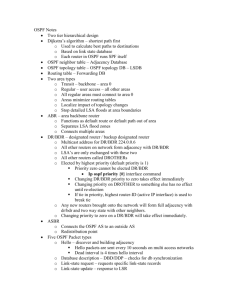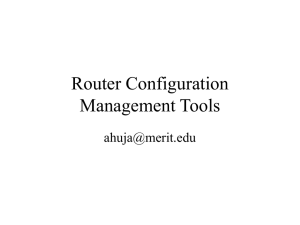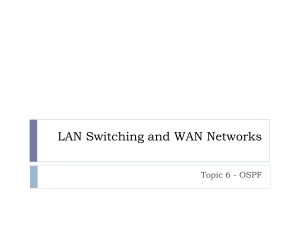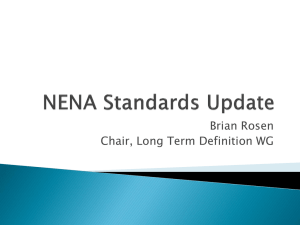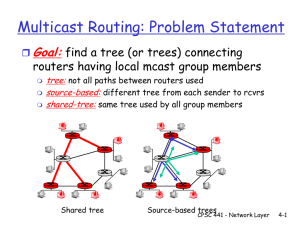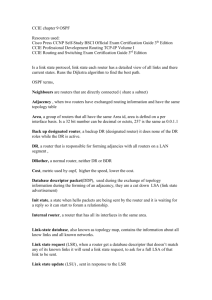OSPF Introduction
advertisement
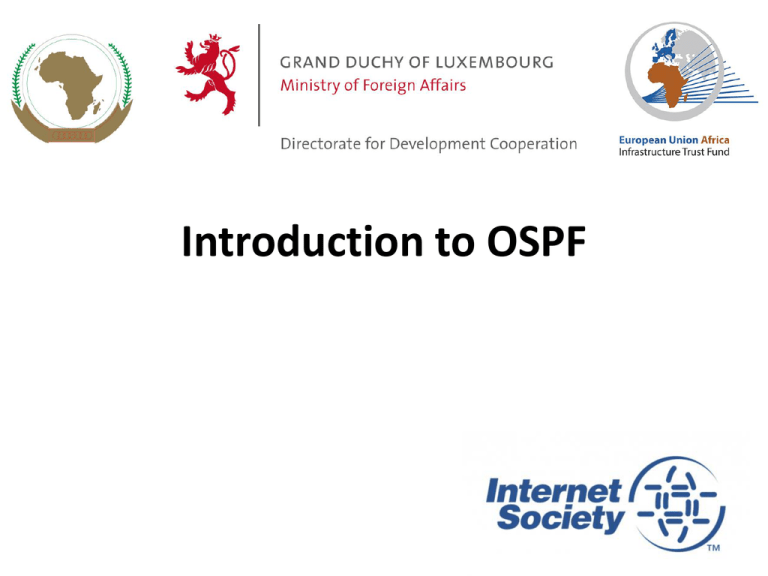
Introduction to OSPF 1 OSPF • Open Shortest Path First • Link state or SPF technology • Developed by OSPF working group of IETF (RFC 1247) • OSPFv2 standard described in RFC2328 • Designed for: – TCP/IP environment – Fast convergence – Variable-length subnet masks – Discontiguous subnets – Incremental updates – Route authentication • Runs on IP, Protocol 89 2 Link State Z’s Link State Q’s Link State Z Q Y X X’s Link State A B C Q Z X 2 13 13 Topology Information is kept in a Database separate from the Routing Table 3 Link State Routing • Neighbour discovery • Constructing a Link State Packet (LSP) • Distribute the LSP – (Link State Announcement – LSA) • Compute routes • On network failure – New LSPs flooded – All routers recompute routing table 4 Low Bandwidth Utilisation LSA X R1 LSA • Only changes propagated • Uses multicast on multi-access broadcast networks 5 Fast Convergence • Detection Plus LSA/SPF – Known as the Dijkstra Algorithm Alternate Path N1 R1 R2 X R3 N2 Primary Path 6 Fast Convergence • Finding a new route – LSA flooded throughout area – Acknowledgement based – Topology database synchronised – Each router derives routing table to destination network LSA N1 R1 X 7 OSPF Areas • Area is a group of contiguous hosts and networks – Reduces routing traffic • Per area topology database R1 R2 Area 2 Rc – Invisible outside the area • Backbone area MUST be contiguous – All other areas must be connected to the backbone Area 0 Backbone Area Rd Rb Ra R5 R8 Area 3 R4 R7 Area 4 R6 Area 1 R3 8 Virtual Links between OSPF Areas • Virtual Link is used when it is not possible to physically connect the area to the backbone • ISPs avoid designs which require virtual links – Increases complexity – Decreases reliability and scalability Rc Area 0 Backbone Area Rd Rb Ra Area 4 R5 R8 R4 R7 Area 1 R6 R3 9 Classification of Routers IR R1 R2 Area 2 IR Area 3 Rc Rb ABR/BR Area 0 Rd Ra ASBR To other AS IR/BR R5 R4 Area 1 R3 • • • • Internal Router (IR) Area Border Router (ABR) Backbone Router (BR) Autonomous System Border Router (ASBR) 10 OSPF Route Types IR R1 IR R2 Area 2 Area 3 Rc Rb ABR/BR Area 0 Rd Ra ASBR To other AS • Intra-area Route – all routes inside an area • Inter-area Route R5 R4 Area 1 R3 – routes advertised from one area to another by an Area Border Router • External Route – routes imported into OSPF from other protocol or static routes 11 External Routes • Prefixes which are redistributed into OSPF from other protocols • Flooded unaltered throughout the AS – Recommendation: Avoid redistribution!! • OSPF supports two types of external metrics – Type 1 external metrics – Type 2 external metrics (Cisco IOS default) OSPF R2 Redistribute RIP EIGRP BGP Static Connected etc. 12 External Routes • Type 1 external metric: metrics are added to the summarised internal link cost Cost = 10 R2 to N1 External Cost = 1 R1 Cost = 8 Network N1 N1 Type 1 11 10 Next Hop R2 R3 R3 to N1 External Cost = 2 Selected Route 13 External Routes • Type 2 external metric: metrics are compared without adding to the internal link cost Cost = 10 R2 to N1 External Cost = 1 R1 Cost = 8 Network N1 N1 Type 1 1 2 Next Hop R2 R3 R3 to N1 External Cost = 2 Selected Route 14 Topology/Link State Database • A router has a separate LS database for each area to which it belongs • All routers belonging to the same area have identical database • SPF calculation is performed separately for each area • LSA flooding is bounded by area • Recommendation: – Limit the number of areas a router participates in!! – 1 to 3 is fine (typical ISP design) – >3 can overload the CPU depending on the area topology complexity 15 The Hello Protocol • Responsible for establishing and maintaining neighbour relationships • Elects designated router on multi-access networks Hello Hello Hello 16 The Hello Packet • Contains: – Router priority – Hello interval – Router dead interval – Network mask – List of neighbours – DR and BDR – Options: E-bit, MCbit,… (see A.2 of RFC2328) Hello Hello Hello 17 Designated Router • There is ONE designated router per multi-access network – Generates network link advertisements – Assists in database synchronization Designated Router Designated Router Backup Designated Router Backup Designated Router 18 Designated Router by Priority • Configured priority (per interface) – ISPs configure high priority on the routers they want as DR/BDR • Else determined by highest router ID – Router ID is 32 bit integer – Derived from the loopback interface address, if configured, otherwise the highest IP address 131.108.3.2 R1 131.108.3.3 DR R1 Router ID = 144.254.3.5 144.254.3.5 R2 R2 Router ID = 131.108.3.3 19 Neighbouring States • Full – Routers are fully adjacent – Databases synchronised – Relationship to DR and BDR Full DR BDR 20 Neighbouring States • 2-way – Router sees itself in other Hello packets – DR selected from neighbours in state 2-way or greater 2-way DR BDR 21 When to Become Adjacent • Underlying network is point to point • Underlying network type is virtual link • The router itself is the designated router or the backup designated router • The neighbouring router is the designated router or the backup designated router 22 LSAs Propagate Along Adjacencies DR BDR • LSAs acknowledged along adjacencies 23 Broadcast Networks • IP Multicast used for Sending and Receiving Updates – All routers must accept packets sent to AllSPFRouters (224.0.0.5) – All DR and BDR routers must accept packets sent to AllDRouters (224.0.0.6) • Hello packets sent to AllSPFRouters (Unicast on point-to-point and virtual links) 24 Routing Protocol Packets • Share a common protocol header • Routing protocol packets are sent with type of service (TOS) of 0 • Five types of OSPF routing protocol packets – – – – – Hello – packet type 1 Database description – packet type 2 Link-state request – packet type 3 Link-state update – packet type 4 Link-state acknowledgement – packet type 5 25 Different Types of LSAs • Six distinct type of LSAs – – – – – – Type 1 : Type 2 : Type 3 & 4: Type 5 & 7: Type 6: Type 9, 10 & 11: Router LSA Network LSA Summary LSA External LSA (Type 7 is for NSSA) Group membership LSA Opaque LSA (9: Link-Local, 10: Area) 26 Router LSA (Type 1) • Describes the state and cost of the router’s links to the area • All of the router’s links in an area must be described in a single LSA • Flooded throughout the particular area and no more • Router indicates whether it is an ASBR, ABR, or end point of virtual link 27 Network LSA (Type 2) • Generated for every transit broadcast and NBMA network • Describes all the routers attached to the network • Only the designated router originates this LSA • Flooded throughout the area and no more 28 Summary LSA (Type 3 and 4) • Describes the destination outside the area but still in the AS • Flooded throughout a single area • Originated by an ABR • Only inter-area routes are advertised into the backbone • Type 4 is the information about the ASBR 29 External LSA (Type 5 and 7) • Defines routes to destination external to the AS • Default route is also sent as external • Two types of external LSA: – E1: Consider the total cost up to the external destination – E2: Considers only the cost of the outgoing interface to the external destination • (Type 7 LSAs used to describe external LSA for one specific OSPF area type) 30 Inter-Area Route Summarisation • Prefix or all subnets • Prefix or all networks • ‘Area range’ command With Network summarisation 1 Without Network summarisation 1.A 1.B 1.C Next Hop R1 Next Hop R1 R1 R1 R2 Backbone Area 0 (ABR) R1 1.A 1.B Area 1 1.C 31 No Summarisation • Specific Link LSA advertised out of each area • Link state changes propagated out of each area 1.A 1.B 1.C 1.D 3.A 3.B 3.C 3.D Area 0 2.A 2.B 2.C 2.D 1.A 1.C 1.B 1.D 3.A 2.A 2.C 2.B 3.C 3.B 3.D 2.D 32 With Summarisation • Only summary LSA advertised out of each area • Link state changes do not propagate out of the area 1 3 Area 0 2 1.A 1.C 1.B 1.D 3.A 2.A 2.C 2.B 3.C 3.B 3.D 2.D 33 No Summarisation • Specific Link LSA advertised in to each area • Link state changes propagated in to each area 2.A 2.C 3.A 3.C 2.B 2.D 3.B 3.D Area 0 1.A 1.C 3.A 3.C 1.A 1.C 1.A 1.C 2.A 2.C 1.B 1.D 3.B 3.D 1.B 1.D 3.A 2.A 2.C 2.B 3.C 1.B 1.D 2.B 2.D 3.B 3.D 2.D 34 With Summarisation • Only summary link LSA advertised in to each area • Link state changes do not propagate in to each area 2 3 1 2 Area 0 1 3 1.A 1.C 1.B 1.D 3.A 2.A 2.C 2.B 3.C 3.B 3.D 2.D 35 Types of Areas • • • • • Regular Stub Totally Stubby Not-So-Stubby Only “regular” areas are useful for ISPs – Other area types handle redistribution of other routing protocols into OSPF – ISPs don’t redistribute anything into OSPF • The next slides describing the different area types are provided for information only 36 Regular Area (Not a Stub) • From Area 1’s point of view, summary networks from other areas are injected, as are external networks such as X.1 ASBR X.1 2 3 X.1 External networks 1 2 X.1 Area 0 X.1 1 3 X.1 1.A 1.C 1.B 1.D X.1 X.1 2.A 2.C 3.A 2.B 3.C 3.B 3.D 2.D 37 Normal Stub Area • Summary networks, default route injected • Command is area x stub ASBR Default 2 3 X.1 External networks 1 2 Default Area 0 Default 1 3 X.1 1.A 1.C 1.B 1.D X.1 X.1 2.A 2.C 3.A 2.B 3.C 3.B 3.D 2.D 38 Totally Stubby Area • • Only a default route injected – Default path to closest area border router Command is area x stub no-summary Totally Stubby Area X.1 Default ASBR X.1 External networks 1 2 Default Area 0 Default 1 3 1.A 1.C 1.B 1.D X.1 X.1 2.A 2.C 3.A 2.B 3.C 3.B 3.D 2.D 39 Not-So-Stubby Area • • • Capable of importing routes in a limited fashion Type-7 LSA’s carry external information within an NSSA NSSA Border routers translate selected type-7 LSAs into type-5 external network LSAs ASBR Not-SoStubby Area X.1 Default Default X.2 1 3 1.A X.2 External networks 1 2 Default X.2 Area 0 1.C 1.B 1.D X.2 X.2 X.1 X.1 2.A 2.C X.1 External networks 3.A 2.B 3.C 3.B 3.D 2.D 40 ISP Use of Areas • ISP networks use: – Backbone area – Regular area • Backbone area – No partitioning • Regular area – Summarisation of point to point link addresses used within areas – Loopback addresses allowed out of regular areas without summarisation (otherwise iBGP won’t work) 41 Addressing for Areas Area 0 network 192.168.1.0 range 255.255.255.192 Area 1 network 192.168.1.64 range 255.255.255.192 Area 2 network 192.168.1.128 range 255.255.255.192 Area 3 network 192.168.1.192 range 255.255.255.192 • Assign contiguous ranges of subnets per area to facilitate summarisation 42 Summary • Fundamentals of Scalable OSPF Network Design – Area hierarchy – DR/BDR selection – Contiguous intra-area addressing – Route summarisation – Infrastructure prefixes only 43 Acknowledgement and Attribution This presentation contains content and information originally developed and maintained by the following organisation(s)/individual(s) and provided for the African Union AXIS Project Cisco ISP/IXP Workshops Philip Smith: - pfsinoz@gmail.com www.apnic.net Introduction to OSPF End 45
